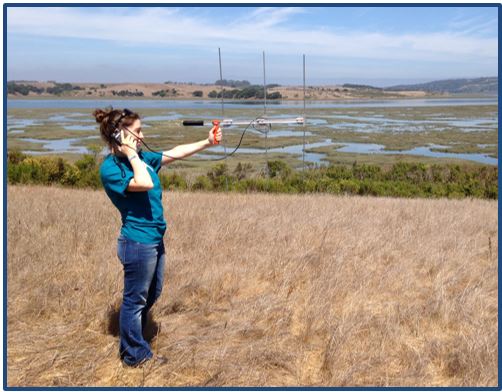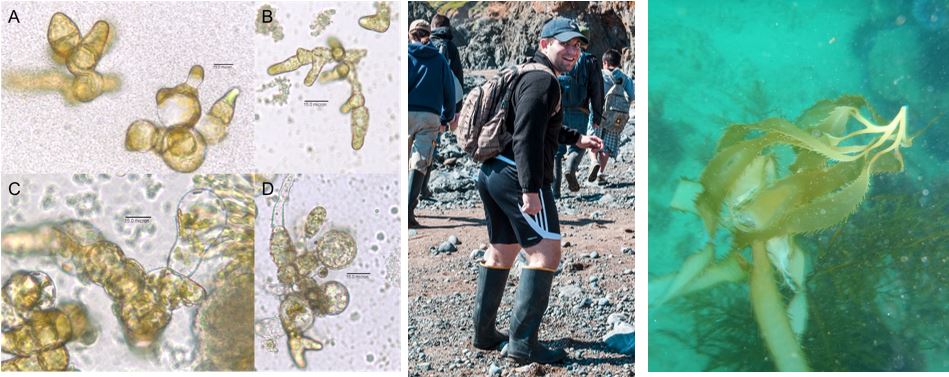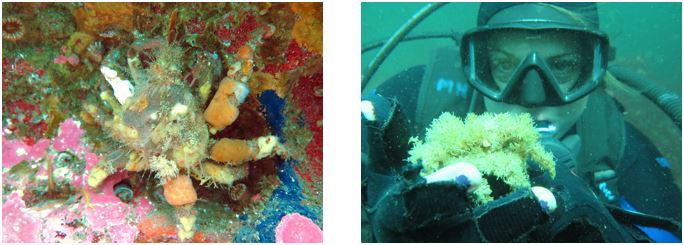By June Shrestha, Ichthyology Lab
Congratulations are in order for the eight students who successfully defended their research theses this past semester (Fall 2016)! Student research spanned from California to French Polynesia, from plankton to marine mammals. Read below to learn about the main points of their research, and if you have any questions or want to get in touch with the recent graduates, please leave a comment!
Estuarine habitat use by the California sea otter (Enhydra lutris nereis)
Jackie Lindsey, Vertebrate Ecology Lab
- I looked at the association between southern sea otters, their essential survival behaviors, and the habitats within Elkhorn Slough.
- Sea otters in this estuary were associated with main channel habitats when they were foraging, but eelgrass and tidal creek habitats when they were resting. They also were found using land habitats up to 150 m from the low tide line.
- These habitat associations let us know regions that are likely to be important within estuaries that sea otters will be colonizing in the future.

Sex-specific diet and rockfish consumption in California sea lions (Zalophus californianus): Insights from molecular scatology
Keith Hernandez, Vertebrate Ecology Lab
- Most variation in California sea lion diets explained by year, rather than by sex.
- Diet consisted of 20+ species of fishes and 5+species of invertebrates (including some never previously recorded!).
- Molecular methods identified at least 16 rockfish species in the diet for the first time.

Gametophyte Fitness and Costs of Self-Fertilization in the Giant Kelp, Macrocystis pyrifera
Robert “Bobby” San Miguel, Phycology Lab
- Giant kelp in different populations exhibit varying costs to self-fertilization.
- Outcrossing results in faster progeny than self-fertilizing.
- We need more people researching gametophyte ecology.

Variation in Organismic RNA and DNA Content: Analysis and Application to the Assessment of Living Planktonic Biomass
Liz Lam Gagneron, Biological Oceanography Lab

Decorating Behavior and Decoration Preference in the Masking Crab, Loxorhynchus crispatus
Catherine Drake, Invertebrate Zoology and Molecular Ecology Lab
- Loxorhynchus crispatus crabs are decorating significantly differently to their environment; males, females, and juveniles may decorate differently from one another, but it depends on the site.
- In the field, juveniles decorate with sessile inverts, males use fleshy algae, and females use both. In the lab, they all use a strawberry anemone (Corynactis californica) and an encrusting bryozoan (Watersipora subtorquata).
- Camouflage may be a driver of the behavior, but not the only one - other factors like ease of attachment, competition for bare space by larvae in the water, and increased predation pressure may be influencing the behavior.

Microbiome sharing between reef-building corals and associated epibiotic gastropods in French Polynesia
Emily Schmeltzer, Invertebrate Zoology and Molecular Ecology Lab
- Corals share the microbes in their surface mucus with epibiotic snails.
- Epibiotic snails have the potential to spread coral disease.
- Corallivores have higher abundances of potentially pathogenic microbes in their mucus layer and have greater disease vector potential than non-corallivores.

Defining the Doratopsis: Investigating the endpoint of the paralarval stage in Chiroteuthis calyx
Alicia Bitondo, Invertebrate Zoology and Molecular Ecology Lab
- Chiroteuthis calyx undergoes a rapid and synchronized change in body shape at the end of the paralarval stage.
- Morphological changes are accompanied by changes in diet and depth distribution.
- New allometric equations can now be used to estimate size and life stage to inform in situ observations of this species.

Temporal and spatial impacts of water control structures on the benthic infaunal community of a tidally restricted wetland in Elkhorn Slough, CA
Christine Mann, Benthic Lab
- Ponding restoration projects are unique and can cause species-specific shifts in benthic infaunal communities.
- With higher inundation in the system, an intertidal was created in the Southern portion, creating a habitat refuge for Batillaria (this non-native snail is declining everywhere else in Elkhorn Slough).

Congrats, everyone! We look forward to following your accomplishments and wish you best of luck in your future pursuits.
Who will be next in 2017?? Stay tuned....
All photos sourced from students.

